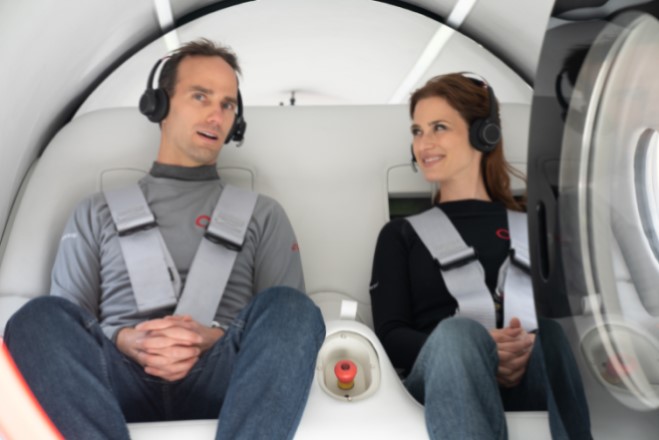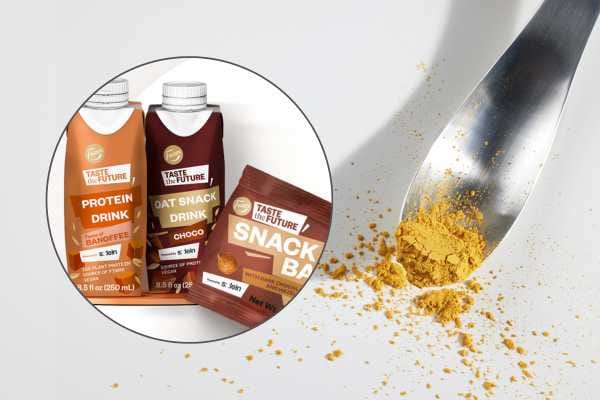First humans ride hyperloop vacuum
Speeding through steel tubes in a vacuum-powered pod – is this the future of sustainable travel?

Two passengers recently travelled inside a hyperloop pod for the first time. Here’s what happened.
Speeding through steel tubes at airline speeds in a vacuum-powered pod – is this the future of sustainable travel?
Powered by electromagnetic propulsion, the hyperloop overcomes the challenges of electrifying long distance, high-speed travel, thanks to its use of low-pressure tubes and low-drag levitated capsules propelled by a highly efficient electric motor that runs on renewable energy.
There are environmental downsides – the effect of the infrastructure on ecosystems and the environmental footprint of the materials used to build it, for instance.
The hyperloop concept was first proposed in 2012 by Elon Musk as an open-source project for anyone to develop. Richard Branson’s Virgin Group plus a handful of others accepted the challenge to commercialise the technology.
Late last year, Virgin Hyperloop One CTO and co-founder Josh Giegel and director of passenger experience Sara Luchian became the first to take one for a spin in the Nevada desert.
The test took place at Virgin Hyperloop’s 500-metre test site in Las Vegas, where more than 400 unoccupied tests have taken place. The pair travelled at a speed of 160 km/h in a two-seater XP-2 vehicle which was specifically built to demonstrate that passengers can in fact safely travel in a hyperloop vehicle (See it in action →). The full production vehicle will be larger and seat up to 28 passengers.
“For the past few years, the Virgin Hyperloop team has been working on turning its ground breaking technology into reality,” Sir Richard Branson, Founder of the Virgin Group said at the time. “With today’s successful test, we have shown that this spirit of innovation will in fact change the way people everywhere live, work, and travel in the years to come.”
"To me, the passenger experience ties it all together. And what better way to design the future than to actually experience it first-hand?"

Sara Luchian said of her experience: “To me, the passenger experience ties it all together. And what better way to design the future than to actually experience it first-hand?”
Fellow passenger Josh Giege said: “Today, we took one giant leap toward that ultimate dream, not only for me, but for all of us who are looking towards a moonshot right here on Earth.”
Last month, Virgin Hyperloop One released a video showcasing its passenger experience (see below), with the company aiming for commercial operation by 2030.
Other companies commercialising the tech are Hyperloop Transportation Technologies in the US, Canadian startup Transpod, Dutch startup Hardt Hyperloop, Spain’s Zeleros, Valais-based startup Swisspod Technologies, Indian-based DGW Hyperloop and Polish company Hyper Poland.
The tech:
Hyperloop vehicles are called pods, and they move using electric propulsion through a low-pressure tube. Magnetic levitation enables speeds of 1000km/h for long distances due to its ultra-low aerodynamic drag. Hyperloop can travel through tunnels or be elevated above ground. In addition to linking cities, it could also enable rural areas to retain residents by providing access to urban job centres, educational opportunities, and health care facilities. These systems could also deliver freight at the speed of flight but at the cost of trucking for delivery of palletised cargo with a focus on high-priority, on-demand goods such as fresh food, medical supplies, electronics, and more.
Who funds it:
Where transportation infrastructure has traditionally relied on government funding, Virgin Hyperloop One says it is more focused on public-private partnerships.
Is it ready to roll:
Virgin Hyperloop One is aiming to have operational systems in the late 2020s, but says its ability to meet that goal will depend on how fast regulatory and statutory processes move.





